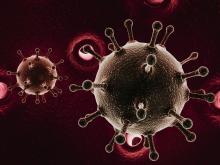User login
More than half of chronic hepatitis B e antigen–negative patients who withdraw from nucleoside or nucleotide analogue therapy experienced relapse within 4 years, according to a new study that looked at patients from 11 centers in Europe, North America, and Asia.
“We wanted to see if the patients stabilize after that year. Are they just having relapses within the first year, and then they’re inactive carriers? Especially patients who don’t achieve [hepatitis B surface antigen; HBsAg] loss. Is that mildly active disease? Would they have been better off being retreated, or are they better off [staying off] therapy? It is important to look at what happens among these patients who stop and if there is a way to tell which way they’re going to go,” said Grishma Hirode, who is a PhD candidate at the University of Toronto. Ms. Hirode presented the multinational study at the annual meeting of the American Association for the Study of Liver Diseases.
The study provided a clear picture: “They do not stabilize after 1 year. They have relapses, and these relapses aren’t mild fluctuations,” said Ms. Hirode. Another study, which was presented during the same session and investigated a national cohort in Taiwan, also found a high rate of flareups and retreatment out to 4 years.
The RETRACT-B study presented by Ms. Hirode collected data on 945 patients from 11 centers in North America, Europe, and Asia. Overall, 66% had at least one relapse within 1 year of drug withdrawal. At 2 years, 40% had a sustained remission without HBsAg loss, as had 20% at 4 years; 44% had sustained remission or HBsAg loss at 2 years, as did 30% at 4 years.
Subgroup analyses found differences between some populations: 48% of Whites and 28% of Asians had sustained remission or HBsAg loss, and 30% of Whites and 20% of Asians had sustained remission without HBsAg loss. Patients who were HBsAg positive at start of therapy were more likely to have a sustained remission or HBsAg loss (36% vs. 28%; P < .05) and to have a sustained remission without HBsAg loss (31% vs. 19%; P < .05). HBsAg levels below 100 IU/mL at cessation was also associated with a greater chance of sustained remission or HBsAg loss (58% vs. 24%; P < .05) and sustained remission without HBsAg loss (24% vs. 20%; P < .05). Not having a relapse within the first year after cessation was also associated with greater chance of sustained remission or HBsAg loss (50% versus 19%; P < .05) and sustained remission without HBsAg loss (37% vs. 13%; P < .05).
The Taiwan cohort study examined the repercussions of a government policy that limited reimbursement of nucleotide/nucleoside analogues to a fixed duration of time. Among 10,192 eligible patients, researchers at I-SHOU University found a 6.58% 4-year cumulative incidence of severe flare-ups after discontinuation (95% confidence interval, 5.91%-7.30%), defined as serum ALT levels higher than five times the upper limit of normal plus serum bilirubin levels above 2 mg/dL.
The overall incidence of flare-ups was 30.66% over 4 years (95% CI, 29.37%-31.96%). Higher risk of flareup was associated with older age (hazard ratio for each 10 years, 1.19; P<.0001), male sex (HR, 1.76; P < .0001), a diagnosis of cirrhosis (HR, 1.84; P < .0001), and a history of hepatic decompensation (HR, 1.45; P = .044).
The 4-year incidence of retreatment was 48.74% (95% CI, 46.55-50.90%)
The mortality rate was 0.63% at 4 years after a flareup (95% CI, 0.44-0.87%), and the combined rate of mortality or liver transplant was 0.79% (95% CI, 0.58-1.05%). Risk factors for higher mortality included older age (per 10 years; HR, 1.70; P < .0001), a diagnosis of cirrhosis (HR, 6.12; P < .0001), and hypertension (HR, 2.29; P = .029).
Selecting patients safely?
The results of both studies suggest that withdrawal from medication should be done cautiously, and patients monitored for relapse and retreatment, according to Anna Lok, MD, who was asked for comment. Dr. Lok is a professor of internal medicine, director of clinical hematology, and assistant dean for clinical research at the University of Michigan, Ann Arbor.
Between the two studies, “the message is that this approach can benefit some patients, but if the goal of treatment withdrawal is to increase the rate of hepatitis B surface antigen loss, only a small percentage of patients would benefit. Contrary to studies in Europe, the rates of HBsAg loss in studies with predominantly Asian patients are much lower,” said Dr. Lok.
The new studies provide guidance as for which patients might safely stop treatment; specifically, she suggested, young White patients who have a low HBsAg level when treatment is stopped. “But you probably shouldn’t be trying it in older Asian patients who still have high HBsAg titer, because the chance of them relapsing is very high and the chance of benefit is very low,” she said.
“One has to be very careful in selecting which patients you’re going to try this on. And if you do want to try, you’ve got to make sure that you monitor patients very carefully so treatment can be promptly resumed if necessary because some of the patients can have a severe flare and they can even develop liver failure, and this should never be tried in patients with cirrhosis” said Dr. Lok.
Ms. Hirode and Dr. Lok have no relevant financial disclosures.
More than half of chronic hepatitis B e antigen–negative patients who withdraw from nucleoside or nucleotide analogue therapy experienced relapse within 4 years, according to a new study that looked at patients from 11 centers in Europe, North America, and Asia.
“We wanted to see if the patients stabilize after that year. Are they just having relapses within the first year, and then they’re inactive carriers? Especially patients who don’t achieve [hepatitis B surface antigen; HBsAg] loss. Is that mildly active disease? Would they have been better off being retreated, or are they better off [staying off] therapy? It is important to look at what happens among these patients who stop and if there is a way to tell which way they’re going to go,” said Grishma Hirode, who is a PhD candidate at the University of Toronto. Ms. Hirode presented the multinational study at the annual meeting of the American Association for the Study of Liver Diseases.
The study provided a clear picture: “They do not stabilize after 1 year. They have relapses, and these relapses aren’t mild fluctuations,” said Ms. Hirode. Another study, which was presented during the same session and investigated a national cohort in Taiwan, also found a high rate of flareups and retreatment out to 4 years.
The RETRACT-B study presented by Ms. Hirode collected data on 945 patients from 11 centers in North America, Europe, and Asia. Overall, 66% had at least one relapse within 1 year of drug withdrawal. At 2 years, 40% had a sustained remission without HBsAg loss, as had 20% at 4 years; 44% had sustained remission or HBsAg loss at 2 years, as did 30% at 4 years.
Subgroup analyses found differences between some populations: 48% of Whites and 28% of Asians had sustained remission or HBsAg loss, and 30% of Whites and 20% of Asians had sustained remission without HBsAg loss. Patients who were HBsAg positive at start of therapy were more likely to have a sustained remission or HBsAg loss (36% vs. 28%; P < .05) and to have a sustained remission without HBsAg loss (31% vs. 19%; P < .05). HBsAg levels below 100 IU/mL at cessation was also associated with a greater chance of sustained remission or HBsAg loss (58% vs. 24%; P < .05) and sustained remission without HBsAg loss (24% vs. 20%; P < .05). Not having a relapse within the first year after cessation was also associated with greater chance of sustained remission or HBsAg loss (50% versus 19%; P < .05) and sustained remission without HBsAg loss (37% vs. 13%; P < .05).
The Taiwan cohort study examined the repercussions of a government policy that limited reimbursement of nucleotide/nucleoside analogues to a fixed duration of time. Among 10,192 eligible patients, researchers at I-SHOU University found a 6.58% 4-year cumulative incidence of severe flare-ups after discontinuation (95% confidence interval, 5.91%-7.30%), defined as serum ALT levels higher than five times the upper limit of normal plus serum bilirubin levels above 2 mg/dL.
The overall incidence of flare-ups was 30.66% over 4 years (95% CI, 29.37%-31.96%). Higher risk of flareup was associated with older age (hazard ratio for each 10 years, 1.19; P<.0001), male sex (HR, 1.76; P < .0001), a diagnosis of cirrhosis (HR, 1.84; P < .0001), and a history of hepatic decompensation (HR, 1.45; P = .044).
The 4-year incidence of retreatment was 48.74% (95% CI, 46.55-50.90%)
The mortality rate was 0.63% at 4 years after a flareup (95% CI, 0.44-0.87%), and the combined rate of mortality or liver transplant was 0.79% (95% CI, 0.58-1.05%). Risk factors for higher mortality included older age (per 10 years; HR, 1.70; P < .0001), a diagnosis of cirrhosis (HR, 6.12; P < .0001), and hypertension (HR, 2.29; P = .029).
Selecting patients safely?
The results of both studies suggest that withdrawal from medication should be done cautiously, and patients monitored for relapse and retreatment, according to Anna Lok, MD, who was asked for comment. Dr. Lok is a professor of internal medicine, director of clinical hematology, and assistant dean for clinical research at the University of Michigan, Ann Arbor.
Between the two studies, “the message is that this approach can benefit some patients, but if the goal of treatment withdrawal is to increase the rate of hepatitis B surface antigen loss, only a small percentage of patients would benefit. Contrary to studies in Europe, the rates of HBsAg loss in studies with predominantly Asian patients are much lower,” said Dr. Lok.
The new studies provide guidance as for which patients might safely stop treatment; specifically, she suggested, young White patients who have a low HBsAg level when treatment is stopped. “But you probably shouldn’t be trying it in older Asian patients who still have high HBsAg titer, because the chance of them relapsing is very high and the chance of benefit is very low,” she said.
“One has to be very careful in selecting which patients you’re going to try this on. And if you do want to try, you’ve got to make sure that you monitor patients very carefully so treatment can be promptly resumed if necessary because some of the patients can have a severe flare and they can even develop liver failure, and this should never be tried in patients with cirrhosis” said Dr. Lok.
Ms. Hirode and Dr. Lok have no relevant financial disclosures.
More than half of chronic hepatitis B e antigen–negative patients who withdraw from nucleoside or nucleotide analogue therapy experienced relapse within 4 years, according to a new study that looked at patients from 11 centers in Europe, North America, and Asia.
“We wanted to see if the patients stabilize after that year. Are they just having relapses within the first year, and then they’re inactive carriers? Especially patients who don’t achieve [hepatitis B surface antigen; HBsAg] loss. Is that mildly active disease? Would they have been better off being retreated, or are they better off [staying off] therapy? It is important to look at what happens among these patients who stop and if there is a way to tell which way they’re going to go,” said Grishma Hirode, who is a PhD candidate at the University of Toronto. Ms. Hirode presented the multinational study at the annual meeting of the American Association for the Study of Liver Diseases.
The study provided a clear picture: “They do not stabilize after 1 year. They have relapses, and these relapses aren’t mild fluctuations,” said Ms. Hirode. Another study, which was presented during the same session and investigated a national cohort in Taiwan, also found a high rate of flareups and retreatment out to 4 years.
The RETRACT-B study presented by Ms. Hirode collected data on 945 patients from 11 centers in North America, Europe, and Asia. Overall, 66% had at least one relapse within 1 year of drug withdrawal. At 2 years, 40% had a sustained remission without HBsAg loss, as had 20% at 4 years; 44% had sustained remission or HBsAg loss at 2 years, as did 30% at 4 years.
Subgroup analyses found differences between some populations: 48% of Whites and 28% of Asians had sustained remission or HBsAg loss, and 30% of Whites and 20% of Asians had sustained remission without HBsAg loss. Patients who were HBsAg positive at start of therapy were more likely to have a sustained remission or HBsAg loss (36% vs. 28%; P < .05) and to have a sustained remission without HBsAg loss (31% vs. 19%; P < .05). HBsAg levels below 100 IU/mL at cessation was also associated with a greater chance of sustained remission or HBsAg loss (58% vs. 24%; P < .05) and sustained remission without HBsAg loss (24% vs. 20%; P < .05). Not having a relapse within the first year after cessation was also associated with greater chance of sustained remission or HBsAg loss (50% versus 19%; P < .05) and sustained remission without HBsAg loss (37% vs. 13%; P < .05).
The Taiwan cohort study examined the repercussions of a government policy that limited reimbursement of nucleotide/nucleoside analogues to a fixed duration of time. Among 10,192 eligible patients, researchers at I-SHOU University found a 6.58% 4-year cumulative incidence of severe flare-ups after discontinuation (95% confidence interval, 5.91%-7.30%), defined as serum ALT levels higher than five times the upper limit of normal plus serum bilirubin levels above 2 mg/dL.
The overall incidence of flare-ups was 30.66% over 4 years (95% CI, 29.37%-31.96%). Higher risk of flareup was associated with older age (hazard ratio for each 10 years, 1.19; P<.0001), male sex (HR, 1.76; P < .0001), a diagnosis of cirrhosis (HR, 1.84; P < .0001), and a history of hepatic decompensation (HR, 1.45; P = .044).
The 4-year incidence of retreatment was 48.74% (95% CI, 46.55-50.90%)
The mortality rate was 0.63% at 4 years after a flareup (95% CI, 0.44-0.87%), and the combined rate of mortality or liver transplant was 0.79% (95% CI, 0.58-1.05%). Risk factors for higher mortality included older age (per 10 years; HR, 1.70; P < .0001), a diagnosis of cirrhosis (HR, 6.12; P < .0001), and hypertension (HR, 2.29; P = .029).
Selecting patients safely?
The results of both studies suggest that withdrawal from medication should be done cautiously, and patients monitored for relapse and retreatment, according to Anna Lok, MD, who was asked for comment. Dr. Lok is a professor of internal medicine, director of clinical hematology, and assistant dean for clinical research at the University of Michigan, Ann Arbor.
Between the two studies, “the message is that this approach can benefit some patients, but if the goal of treatment withdrawal is to increase the rate of hepatitis B surface antigen loss, only a small percentage of patients would benefit. Contrary to studies in Europe, the rates of HBsAg loss in studies with predominantly Asian patients are much lower,” said Dr. Lok.
The new studies provide guidance as for which patients might safely stop treatment; specifically, she suggested, young White patients who have a low HBsAg level when treatment is stopped. “But you probably shouldn’t be trying it in older Asian patients who still have high HBsAg titer, because the chance of them relapsing is very high and the chance of benefit is very low,” she said.
“One has to be very careful in selecting which patients you’re going to try this on. And if you do want to try, you’ve got to make sure that you monitor patients very carefully so treatment can be promptly resumed if necessary because some of the patients can have a severe flare and they can even develop liver failure, and this should never be tried in patients with cirrhosis” said Dr. Lok.
Ms. Hirode and Dr. Lok have no relevant financial disclosures.
FROM THE LIVER MEETING


